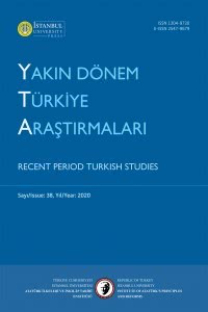ABD Basınında Temsiliyet Ve Dış Politika: II. Sason İsyanı, Norton Raporu Ve Çift Kademeli Tarafgirlik Üzerine
Ermeni isyanlarının Batı basınındaki tarafgir temsilidir. Osmanlı Devleti’nin Ermeni komitacılara karşı aldığı tedbirler, batılı okuyuculara kasıtlı ve çok yönlü çarpıtmalarla aktarılmıştır. Bu makalede de en şiddetli dönemi 1904 yılının Nisan- Mayıs aylarında yaşanan II. Sason isyanının Amerikan kamuoyuna aktarılış biçimi hakkında bir örnek incelenecektir. Harput’taki ABD konsolosu Thomas H. Norton, II. Sason isyanının sonuçlarını incelemek üzere Muş, Sason, Bitlis ve Van çevresinde dolaştıktan sonra bir rapor hazırlamıştır. Bu raporun bir kısmı ABD Dışişleri Bakanlığı tarafından basına servis edilmiş ve gazeteler de bu husus hakkında haber yapmışlardır. Makale mezkûr haberler ve Norton Raporu’nun orijinal metnini mukayeseli olarak incelemektedir. Söz konusu kaynaklar, yapısökümcü bir perspektifle ele alınmış, dış politika ve basındaki söylemler arasındaki ilişkiler bağlamında hadiselerin tahrif edilerek okuyucuya aktarılması gözler önüne serilmiştir.
Anahtar Kelimeler:
ABD Basınında Türkiye, II. Sason İsyanı, Norton Raporu, Ermeni İsyanları, Dış Politika, Türkiye in the U.S. Press, Second Sasun Revolt, Norton Report, Armenian Revolts, Foreign Policy
Representation and Foreign Policy In The U.S. Press: On The Second Sasun Revolt, Norton Report And Two-Staged Bias
One of the important parts of the orientalist “grand narrative” that provides public legitimacy for the intervention of Western states in the internal affairs of the Ottoman Empire is the biased representation of the Armenian revolts in the Western press. The measures taken against the Armenian comitadjis were reported to the Western readers with deliberate and versatile distortions. In this article, an example of how the second Sasun revolt, the most violent period of which was experienced in April-May 1904, was conveyed to the American public will be examined. Thomas H. Norton, the U.S. consul in Harput, prepared a report after traveling around Muş, Sason, Bitlis, and Van to examine the consequences of the second Sasun revolt. A part of this report was served to the press by the US Department of State and newspapers also reported on this issue. The article examines the aforementioned news and the original text of the Norton Report comparatively. The sources in question were evaluated with a deconstructive perspective, and in the context of foreign policy and discourses in the press, the manipulation of the events and their conveyance to the reader were revealed.
Keywords:
Türkiye in the U.S. Press, Second Sasun Revolt, Norton Report, Armenian Revolts, Foreign Policy,
___
- Balkin, Jack M. “Deconstruction”, içinde, Dennis M. Patterson, A Companion to Philosophy of Law and Legal Theory. Blackwell, 1996.
- Barton, James L. Daybreak in Turkey. New York: The Pilgrim Press, 1908.
- Brailsford, H. N. “The Armenian Blue-Book.” The Speaker: The Liberal Review, Oct 22, (1904): 79.
- Chalabian, Antranig. Revolutionary Figures. USA, 1994.
- Çelik, Nihat. “XIX. Yüzyılda Osmanlı İmparatorluğunda Sason Ermenileri ve Sason Ermeni İsyanları.” Yüksek Lisans Tezi, Batman Üniversitesi, 2016.
- Doğan, Hamdi. “Sason Ermeni İsyanları.” Doktora Tezi, Niğde Üniversitesi, 2000. Halaçoğlu, Yusuf. Ermeniler’in Suriye’ye Nakli: Sürgün mü? Soykırım mı?. Ankara:ATO Yayınları, 2004.
- Köse, İsmail. “Ermeni İsyanlarının Amerikan Gazetelerindeki Yansımaları.” Türk-Ermeni İlişkilerinin Bölgesel Politikalara Etkisi (19.Yüzyıldan Günümüze) Uluslararası Sempozyumu. (2016): 745-766.
- Mazzei, Lisa A. “A Deconstructive Methodology”, Counterpoints, Cilt 318 (2007): 13-26. Melson, Robert. “A Theoretical Inquiry into the Armenian Massacres of 1894-1896.” Comparative Studies in Society and History 3, Cilt 24 (1982): 481-509.
- McCarthy, Justin, Ömer Turan ve CemalettinTaşkıran. Sasun: The History of an 1890s Armenian Revolt. University of Utah Press, 2014.
- Norton, Thomas H. “Report of a tour of Investigation through the Vilayets of Bitlis and Van”, No. 136, American Consulate, Harput, Turkey, October 13, 1904. August 25, 1904 - October 22, 1904. MS Turkey: Records of the U.S. Department of State, 1802-1949: Despatches From U.S. Consuls in Harput, Turkey, 1895-1906. National Archives (United States).
- Osmanlı Belgelerinde Ermani İsyanları Cilt III, T.C. Başbakanlık Devlet Arşivleri Genel Müdürlüğü, Ankara, 2008
- Öney, Celal. “Amerikan Board ve Sason Ermeni İsyanının Amerika’da Propaganda Aracı Olarak Kullanılması.” Batman University Journal of Life Sciences 1, Cilt 1 (2012): 207-224.
- Özger, Yunus. “Ermeni Ayaklanmalarında Fedailerin Uyguladığı Stratejiler.” Ermeni Araştırmaları 31 (2008): 53-68.
- Rodogno, Davide. Against Massacre: Humanitarian Interventions In The Ottoman Empire, 1815–1914, The Emergence of a European Concept and International Practice. Princeton University Press, 2012.
- Sarınay, Yusuf. 24 Nisan 1915’de Ne Oldu?. İstanbul: İdeal Kültür Yayıncılık, 2012.
- Tekin, Beyza C. Representations and Othering in Discourse: The Construction of Turkey in the EU Context. Amsterdam: John Benjamins Publishing Company, 2010.
- Tiryakioğlu, Nevsal O. “The Western Image of Turks from the Middle Ages to the 21st Century: The Myth of ‘Terrible Turk’ and ‘Lustful Turk’.” Doktora Tezi, Nottingham Trent University, 2015.
- Uras, Esat. Tarihte Ermeniler ve Ermeni Meselesi. İstanbul: Belge Yayınları, 1987.
- Van Dijk, Teun A. News as Discourse. New Jersey: Lawrence Erlbaum Associates Publishers, 1988.
- Yanık, Hayrullah. “Yapısöküm Üzerine Birkaç Not.” Abant Kültürel Araştırmalar Dergisi 1, No 2 (2016): 91-98.
- Yüksel, Mevlüt. “Erzurum, Bitlis ve Mamuretülaziz Vilayetlerindeki Ermeni İsyanları.” Ermeni Araştırmaları 42 (2012): 165-194.
- “Consul Tells of Massacres”, The San Fransisco Call, Ocak 23, 1905 “Slain by the Kurds”, The Washington Post, Ocak 23, 1905.
- “The Sassoun Massacre, Proof of the Assertion that Armenian Revolutionists Caused It”, New York Times, Ağustos 23, 1895.
- ISSN: 1304-9720
- Başlangıç: 2002
- Yayıncı: İstanbul Üniversitesi Atatürk İlkeleri ve İnkılap Tarihi Enstitüsü
Sayıdaki Diğer Makaleler
Milli Mücadele Döneminde Sıhhat ve Muavenet-i İçtimaiye Vekillerinin Faaliyetleri
Arşivcilikte Değerlendirme ve İmha: Arşivsel Teori Tarihi Bağlamında Bir Değerlendirme
Çok Partili Hayata Geçiş Döneminde Türkiye’de Orman ve Ormancılık Politikası (1946-1950)
Yeni Kafkasya Dergisinde Kafkasya Halklarının Bağımsızlık Sorunu
II. Meşrutiyet Dönemi Irak’ında İttihatçı Bir Vali: Cemal Bey’in Bağdat Valiliği (1911-1912)*
Sakarya Meydan Muharebesi’nde Türk Ordusunun Kuruluş ve Konuşu
Mehmet Akif OKUR, Mustafa Onur TETİK
Türk-İngiliz İlişkileri Bağlamında İngiltere'nin Akdeniz Filosu'nun 1929 Yılı Türkiye Ziyareti
